How To Assess Group Media Tasks (One Potential Method)
By Diana Maliszewski with Neil Andersen
Students can create some astounding media creations, especially as a collaborative venture. The challenge can be about how to evaluate the end-product, especially when it was a cooperative endeavour. How do you weigh the various types of contributions made by different individuals? This causes anxiety in teachers but the stress can be alleviated. (At the risk of sounding like “click-bait”, read below to see how!)
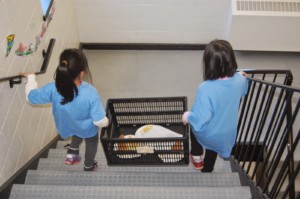
Hello, I’m Diana Maliszewski and I’m a media educator. This is my story, or at least one of them. In the 2014-2015 school year, I decided, based on conversations that indicated that my students would be receptive to the idea, that the Grade 1-4 classes that I saw for media would like to learn about restaurants as a media text. This was an incredibly engaging and relevant inquiry. I wrote about parts of the process on my own personal blog and you can examine the various stages there. Some of the activities included:
Pre-Planning Restaurant-Related Tasks

Brainstorming Restaurant Types / Names / Logos
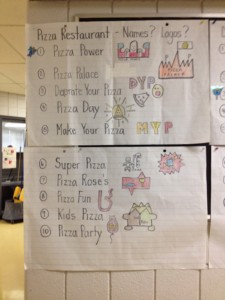
Our culminating task was to create our own restaurants. You can read about the successes and failures of this huge endeavor on this blog post,
… but what concerned me, even in the early stages, was how I was going to determine a grade. I spoke to Neil Andersen (current president of The Association for Media Literacy and an educator with years of experience teaching media), who helped me create a set of tools that was incredibly helpful. Neil confirmed for me that individual assessment of group work is possible with well-crafted, differentiated assessment tools. These tools, which incorporated a combination of strategies, was so useful that I’ve modified parts for other collaborative projects throughout the subsequent years.
Before creating an amazing assessment, consider this: why do all the heavy lifting yourself? This combination of rubric and reflection questions involved the students evaluating themselves.
Neil encouraged me to use the achievement chart for language and the four categories (knowledge and understanding / thinking / communication / application) as a guide for developing this particular assessment tool. We examined what I thought were the important main ideas based on the curriculum expectation and the task description. We also looked at student-friendly language. To be honest, I cannot remember if this was co-created with the students or not. Here are parts of the rubric.
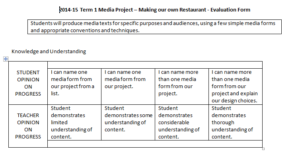
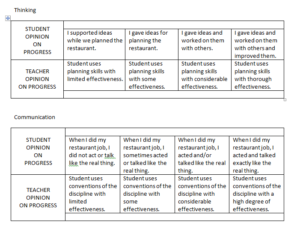
Where’s the evidence? How can we tell that the student opinion (or the teacher opinion, for that matter) are based on “facts”? What can be used to justify the self-given (or assigned) mark? That’s where the second portion, involving reflection questions, comes into play. What I really liked about this section was that students were given options – they could choose how to answer the questions. (As I’ve returned to this strategy, I’ve also broadened the choice to which questions they wanted to answer – some were mandatory but some could be selected from a few options.)
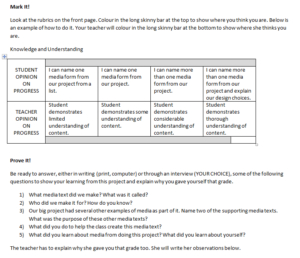
This rubric was still pretty wordy for some of my youngest learners and for some of my English Language Learners. Therefore, I redesigned the rubric to use less words and more visuals to make the distinctions between the levels clearer. I used Bitstrips for Schools (an online comic creation site that sadly no longer exists) to make my illustrations.
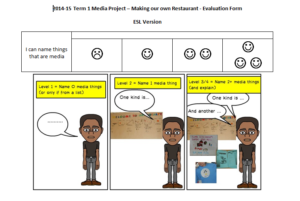
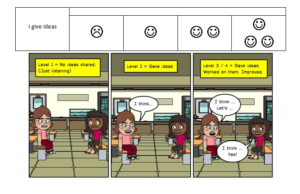

This took a while to create, explain, and provide time to complete, but the end results were wonderful. You can access the PDFs to the assessment tools made for this unit here (Restaurant Creation Evaluation Form) and here (Restaurant Creation Evaluation ESL). You can read some of the answers, at least to the last two questions, in this blog post:

Now, I’m neither claiming that this is the only way to evaluate group projects, nor am I claiming that this approach is particularly ground-breaking or magical. However, when
- students are involved with the assessment (of themselves and/or their peers, making and/or using the evaluation tool)
- students are given choice in how they can provide/use the evaluation (within reason, aka bounded choice)
- students can answer reflection questions (of various types) that permit them to provide or point to evidence of their learning
then it becomes somewhat easier to determine individual achievement, at least for the purpose of providing a report card mark. Some other assessment pieces that could be used include:
- colouring pie graphs to indicate level or degrees of participation / effort / etc.
- single point rubrics (see https://www.cultofpedagogy.com/single-point-rubric/ )
- “before I thought” / “now I know” pre- and post-task observations
- structured commentary provided to other students (like “2 stars and a wish” or a “glow and grow”)
I thank Neil for articulating the final thoughts to this article:
“Students work in groups but are evaluated as individuals using differentiated assessment tools. This can address a key teacher anxiety involving group work. Ironically, this is the same issue in the workplace, where people often work in teams but undergo work reviews individually. When that happens, the reviews are usually done as interviews, which are solo. Why not do this in class?”
(These lesson ideas are adaptable to both Elementary and Secondary school classrooms – ed.)



